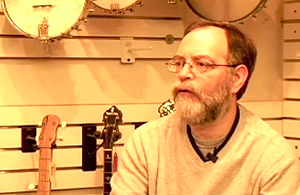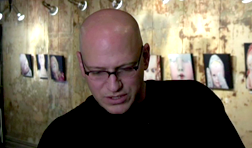Collecting the Evidence
Confronted with such a complex, interesting, and emotionally
arresting story, we felt out of our league. However, we grabbed a bunch
of video equipment like boom microphones and video cameras from Dr.
Halbritter’s stash of gear in the Michigan State Documentary Lab and
began shooting. When approaching our initial shooting dates, we made
sure to keep the stakes low, not scheduling any major interviews that
we knew were critical to the success of our final narrative. Therefore,
we started by collecting B-roll and doing practice interviews on each
other so that we could learn from our mistakes. Our initial attempts
were marred by a multitude of technical errors. For example, we often
hooked up the sound equipment incorrectly, leading to badly garbled
audio or no audio at all. And for each mistake we corrected, another
one would rear its ugly head. We would do an interview and forget to
hit record. Or we would set the white balance incorrectly, in one case
leading to the interview subject having a jaundiced skin-tone.  Or we would neglect to use a tripod, not fully realizing its value,
leading to video which could be slapped with the label: “Warning: may
cause nausea and dizziness.” The project suddenly seemed hugely
daunting... and frustrating. Our first few weeks of filming were one
problem after the other, and with our tight schedules, it was hard to
see the light at the end of the tunnel. How could we hope to complete a
twenty minute documentary that would do justice to the memory of Mr.
Busby?
Or we would neglect to use a tripod, not fully realizing its value,
leading to video which could be slapped with the label: “Warning: may
cause nausea and dizziness.” The project suddenly seemed hugely
daunting... and frustrating. Our first few weeks of filming were one
problem after the other, and with our tight schedules, it was hard to
see the light at the end of the tunnel. How could we hope to complete a
twenty minute documentary that would do justice to the memory of Mr.
Busby?
Luckily, thanks to the foresight of Dr. Halbritter, each group presented their research and materials weekly to the class. These regular sessions allowed us to voice our frustrations as well as have a discussion about how to improve upon the material we had collected so far. Dr. Halbritter, seeing that we were floundering somewhat, not only to acquire the sheer amount of material the original project scope would require, but also with the creation of quality content, suggested that we shift the focus of our project. Instead of trying to make a complete documentary, he suggested instead that we approach the film as a “making of”, “behind the scenes” type of film. This would help the project in numerous ways. First, we would be interviewing each other, which meant we wouldn’t need to schedule all of our free time away to meet with people in Old Town. We wouldn’t need to transport large amounts of equipment to and fro; instead, we were able to shoot our interviews in and around class periods. We were also able to contribute more to the project on an individual basis. We interviewed ourselves using the webcams on our computer. In addition, interviewing each other gave us practice with the interview process and the video equipment before sitting down with an external subject for an interview we’d have to get right. We could stumble over our words, and feel comfortable that we wouldn’t look stupid, although later we made the conscious decision to include some of those stupid moments in the final product. We were able to relieve ourselves of the pressure to create a complete picture of the complex nature of Robert Busby and Old Town Lansing. Instead, we could focus on the process of learning what we needed to know to pursue a large-scale, multimedia-based, inquiry project.
When our final weekend of shooting came around, we set up four
one-hour interviews at the Creole Gallery, the art gallery that Mr.
Busby owned, and checked out every piece of video equipment from the
documentary lab. We got there early on a Saturday morning, and when we
were finished shooting Mr. Busby's friends and colleagues that
afternoon we had footage that, in my opinion, was close to professional
quality. The audio was crisp and clear. The visuals were well
contrasted, with the subjects well contrasted against rich, dark
backgrounds. And our interview technique, honed through our research
and practice interviews, was pointed. We knew the questions we wanted
to ask, and the kind of answers we needed to get to complete the
picture of Robert Busby we had started to paint in our heads. Dennis
Preston, an artist, gave perspective about Busby as an artist and
patron of the arts.  Richard Karp, a real estate developer, talked about Robert Busby the
community leader and real estate rehabilitator. Bonnie Sumbler bared
her heart about Robert Busby, her friend, and the incredible kindness
he possessed. They said what we needed to hear. We saw what we wanted
to see. At the end of shooting, we had a pile of about ten
seventy-minute high-definition video tapes, some footage shot on
webcams and camcorders, and a video given to us by a friend which
showed Busby at an art show at his gallery. We took this stack of
material to the editing room to figure out where to go next.
Richard Karp, a real estate developer, talked about Robert Busby the
community leader and real estate rehabilitator. Bonnie Sumbler bared
her heart about Robert Busby, her friend, and the incredible kindness
he possessed. They said what we needed to hear. We saw what we wanted
to see. At the end of shooting, we had a pile of about ten
seventy-minute high-definition video tapes, some footage shot on
webcams and camcorders, and a video given to us by a friend which
showed Busby at an art show at his gallery. We took this stack of
material to the editing room to figure out where to go next.